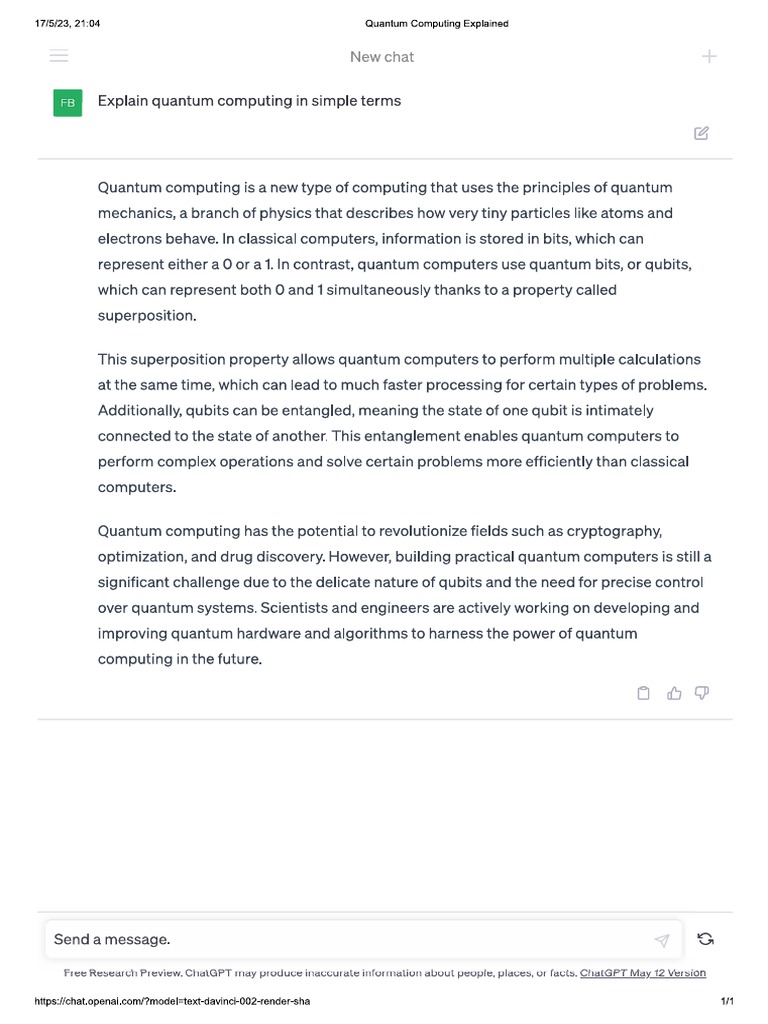Quantum computing stands as a fascinating frontier in the field of technology, melding principles of quantum mechanics with computational analysis to forge a revolutionary approach to problem-solving. What exactly sets quantum computing apart from classical computing? To unravel this puzzle, we must first define quantum computing and outline its various types, complemented by illustrative examples.
At its core, quantum computing exploits the unique behaviors of quantum bits, or qubits. Unlike classical bits, which exist in a state of either 0 or 1, qubits can exist in a superposition of states. This means a qubit can simultaneously be in the state of 0, the state of 1, or any quantum superposition thereof, providing a far richer informational landscape. Additionally, qubits can be entangled, a phenomenon whereby the state of one qubit is intrinsically linked to the state of another, regardless of the distance separating them. These characteristics allow quantum computers to process vast amounts of data at unprecedented speeds, making them uniquely suited for solving complex problems that traditional computers struggle with.
However, the discussion of quantum computing would be incomplete without delineating its various types, each characterized by distinct operational paradigms and implementation methodologies.
1. Quantum Gate Model
The quantum gate model encapsulates the prevailing framework for quantum computation, drawing parallels with classical logic gates. Within this model, computations are performed through a series of quantum gates, which manipulate the state of qubits. The gates facilitate operations like superposition, entanglement, and measurement. Classical examples of quantum gates include the Hadamard gate, which places a qubit into a superposition, and the CNOT (Controlled-NOT) gate, which entangles two qubits.
An illustrative example of a quantum algorithm employing the quantum gate model is Shor’s algorithm, which efficiently factors large integers. This algorithm poses an intriguing challenge to classical cryptography, as it significantly reduces the time required to break widely used encryption protocols.
2. Quantum Annealing
Quantum annealing represents an alternative computational paradigm, optimized for solving optimization problems. This approach exploits quantum effects to search through a solution space efficiently. During this process, the system evolves towards a low-energy state, representing the optimal solution.
One noteworthy application of quantum annealing can be observed in D-Wave Systems, which utilizes this method to address problems in logistics, finance, and machine learning. For instance, a logistics company may use quantum annealing to optimize delivery routes, minimizing travel time and fuel consumption, thus posing an exciting challenge in operational efficiency and resource management.
3. Topological Quantum Computing
Topological quantum computing takes a novel approach by utilizing anyons—exotic particles that exist in two-dimensional space and exhibit non-abelian statistics. This type of quantum computer harnesses the braiding of these anyons to perform computations, which inherently resist decoherence, a major obstacle in the development of stable quantum systems.
Research in topological quantum computing is still in its infancy, but an enticing illustration of its potential lies in quantum error correction. This feature enables topological qubits to remain resilient against environmental disturbances, a significant hurdle for traditional qubit systems. The challenge of achieving error-tolerant quantum computation invites immense scientific inquiry, as it may lead to robust quantum systems capable of real-world applications.
4. Measurement-based Quantum Computing
Measurement-based quantum computing shifts the focus from unitary operations to measurements as the primary computational mechanism. In this model, entangled states are prepared in advance, and the computation is realized through a series of measurements on the qubits. The results of these measurements dictate subsequent operations, thereby guiding the course of the computation.
An intriguing example of this type of quantum computation is the cluster state model, which employs highly entangled states, known as cluster states, to perform computation through localized measurements. The challenge here lies in the efficient generation and manipulation of complex entangled states, presenting an array of potential experimental obstacles.
5. Quantum Simulation
Quantum simulation serves as an ancillary application of quantum computing, allowing researchers to model and study complex quantum systems that are impractical for classical computers to simulate. By leveraging the principles of quantum mechanics, scientists can investigate phenomena such as high-temperature superconductivity and quantum phase transitions.
A seminal example of quantum simulation is the ability to model chemical reactions at the quantum level, potentially leading to breakthroughs in drug discovery and material science. The challenge presented by quantum simulation lies in achieving sufficient precision and quality in the simulations to yield viable scientific results.
In conclusion, quantum computing represents a transformative advancement in computation, distinguished by its unique operational paradigms and capabilities. As technologies mature, the interplay between theoretical exploration and practical implementation will increasingly illuminate the path forward, challenging our understanding of logic, computation, and the very nature of reality. The journey through quantum computing not only poses profound questions about the limitations of classical systems but also beckons those who dare to innovate at the intersection of science and technology.












